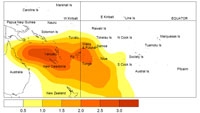Tropical Cyclone guideance for the 2007-08 season

Dr Jim Salinger, Stuart Burgess, and Dr Jim Renwick, NIWA
Lower risk of tropical cyclones east of the Date Line but all islands should remain vigilant.
For the coming tropical cyclone season, from November 2007-May 2008, we are likely to see an average risk of occurrence for those areas of the South Pacific near the Date Line. These countries include Tuvalu, Fiji, Wallis and Futuna, Tonga, and Niue. However, a reduced risk of tropical cyclones is likely in several parts of the South Pacific east of the Date Line. Islands west of the Date Line are still likely to experience tropical cyclones, with a near normal rate of occurrence.
Tropical sea surface temperatures, which play an important role in the development of tropical cyclones, are presently below average along the equator across the entire Pacific Basin east of the DateLine. A weak La Niña has developed although conditions in the western Pacific do not yet exhibit this behaviour. This reduces the risk of tropical cyclones east of the Date Line. On average six or seven tropical cyclones can be expected over the entire Southwest Pacific region during a weak La Niña season. This compares with an average of nine or ten over all seasons.
There is a good chance that the first tropical cyclone of the coming season in the South Pacific region may occur before the end ofDecember, which is normal in both neutral and La Niña seasons. In seasons similar to the present, several tropical cyclones usually occur in the region between Vanuatu, New Caledonia, Fiji, and Tonga, with some affecting other areas. In an average season about half of the tropical cyclones that develop reach hurricane force with mean wind speeds at least 64 knots (118 km/h). Southwest Pacific tropical cyclones are grouped into classes ranging from 1 to 5, with 5 being the strongest. On average four per season reach at least class 4 with mean wind speeds of at least 64 knots or 118 km/h, while two usually reach class 5 with mean speeds in excessof 90 knots or 167 km/h. Last season (2006/07) Cyclone Xavier was particularly severe, reaching class 5 in strength, fortunately missing populated areas. Two others were class 5.
| Country | Average over all years | Average over weak La Niña years | Comments |
|---|---|---|---|
| Tuvalu | 1.1 | 0.8 | Average risk |
| Fiji | 2.3 | 2.1 | Average risk |
| Wallis and Futuna | 1.8 | 1.8 | Average risk |
| Tonga | 2.0 | 2.1 | Average risk |
| Tokelau | 0.8 | 0.8 | Average risk |
| Solomon Islands | 1.3 | 0.7 | Variable risk - uncertain |
| Vanuatu | 3.0 | 2.4 | Variable risk - uncertain |
| New Caledonia | 2.7 | 2.4 | Variable risk - uncertain |
| Samoa | 1.5 | 1.1 | Variable risk - uncertain |
| Niue | 1.9 | 1.3 | Variable risk - uncertain |
| Papua New-Guinea | 0.6 | 0.3 | Reduced risk |
| Northern Cook Islands | 0.8 | 0.2 | Reduced risk |
| Southern Cook Islands | 1.5 | 0.6 | Reduced risk |
| Society Islands | 0.8 | 0.3 | Reduced risk |
| Tuamotu Islands | 0.4 | 0.0 | Reduced risk |
| Austral Islands | 0.8 | 0.1 | Reduced risk |
| Pitcairn Island | 0.3 | 0.0 | Reduced risk |
| Marquesas Islands | 0.1 | 0.0 | Cyclones unlikely |
| Western Kiribati | 0.0 | 0.0 | Cyclones unlikely |
| Eastern Kiribati |
0.0 |
0.0 | Cyclones unlikely |
The average number of tropical cyclones passing within 5º (550 km circle) of the main island groups of the Southwest Pacific over the full November through May period. (Based on 37 seasons of data, and for tropical cyclones having mean wind speeds over 34 knots).
For further information: http://www.niwascience.co.nz/news/mr/2007/2007-09-21 In the Pacific islands contact your local Meteorological Service.
